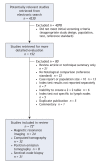Diagnostic accuracy of tests for lymph node status in primary cervical cancer: a systematic review and meta-analysis
- PMID: 18362381
- PMCID: PMC2267838
- DOI: 10.1503/cmaj.071124
Diagnostic accuracy of tests for lymph node status in primary cervical cancer: a systematic review and meta-analysis
Abstract
Background: Lymph node status is the key to determining the prognosis and treatment of cervical cancer. However, it cannot be assessed clinically, and testing for nodal metastasis is controversial. We sought to systematically review the diagnostic accuracy literature on sentinel node biopsy, positron emission tomography, magnetic resonance imaging and computed tomography to evaluate the accuracy of each index test in determining lymph node status in patients with cervical cancer.
Methods: We searched MEDLINE (1966-2006), EMBASE (1980-2006), Medion (1980-2006) and the Cochrane library (Issue 2, 2006) for relevant articles. We also manually searched the reference lists from primary articles and reviews, and we contacted experts in the field for conference abstracts and unpublished studies. We performed random-effects meta-analysis of accuracy indices, and we performed meta-regression analysis to test the effect of study quality on diagnostic accuracy and to identify other sources of heterogeneity.
Results: We included 72 relevant primary studies, involving a total of 5042 women, in our analysis. We found that, in determining lymph node status, sentinel node biopsy had a pooled positive likelihood ratio of 40.8 (95% confidence interval [CI] 24.6-67.6) and a pooled negative likelihood ratio of 0.18 (95% CI 0.14-0.24). The pooled positive likelihood ratios (and 95% CI) were 15.3 (7.9-29.6) for positron emission tomography, 6.4 (4.9-8.3) for magnetic resonance imaging and 4.3 (3.0-6.2) for computed tomography. The pooled negative likelihood ratios (and 95% CIs) were 0.27 (0.11-0.66) for positron emission tomography, 0.50 (0.39-0.64) for magnetic resonance imaging and 0.58 (0.48-0.70) for computed tomography. Using a 27% pretest probability of lymph node metastasis among all cases (regardless of stage), we found that a positive sentinel node biopsy result increased post-test probability to 94% (95% CI 90%-96%), whereas a positive finding on positron emission tomography increased it to 85% (75%-92%).
Interpretation: Sentinel node biopsy has greater accuracy in determining lymph node status among women with primary cervical cancer than current commonly used imaging methods.
Figures


Comment in
-
Imaging of lymph node metastases in cervical cancer.CMAJ. 2008 Mar 25;178(7):867-9. doi: 10.1503/cmaj.080157. CMAJ. 2008. PMID: 18362383 Free PMC article. No abstract available.
References
-
- National Cancer Institute. Cervical cancer. Bethesda (MD): The Institute. Available: www.cancer.gov/cancertopics/types/cervical (accessed 2008 Feb 21).
-
- Arbyn M, Raifu AO, Ferlay J. Burden of cervical cancer in Europe. Ann Oncol 2007;18:1708-15. - PubMed
-
- Hatch K. Cervical cancer. In: Berek JS, Hacker NF, editors. Practical gynecologic oncology. 2nd ed. Baltimore: Williams & Wilkins; 1994. p. 243-85.
-
- Scheidler J, Hricak H, Yu KK, et al. Radiological evaluation of lymph node metastases in patients with cervical cancer. A meta-analysis. JAMA 1997;278:1096-101. - PubMed
-
- Bipat S, Glas AS. van d, V, Zwinderman AH, Bossuyt PM, Stoker J. Computed tomography and magnetic resonance imaging in staging of uterine cervical carcinoma: a systematic review. Gynecol Oncol 2003;91:59-66. - PubMed
Publication types
MeSH terms
LinkOut - more resources
Full Text Sources
Medical
Molecular Biology Databases
